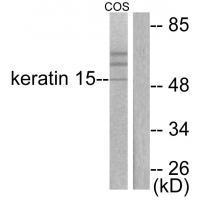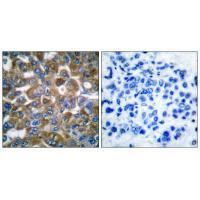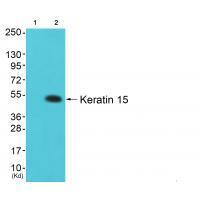


| WB | 咨询技术 | Human,Mouse,Rat |
| IF | 咨询技术 | Human,Mouse,Rat |
| IHC | 1/50-1/100 | Human,Mouse,Rat |
| ICC | 1/100-1/500 | Human,Mouse,Rat |
| FCM | 咨询技术 | Human,Mouse,Rat |
| Elisa | 1:20000-1:40000 | Human,Mouse,Rat |
| Aliases | Keratin type I cytoskeletal 15; Cytokeratin-15; CK-15; K15; |
| Entrez GeneID | 3866; |
| WB Predicted band size | 50kDa |
| Host/Isotype | Rabbit IgG |
| Antibody Type | Primary antibody |
| Storage | Store at 4°C short term. Aliquot and store at -20°C long term. Avoid freeze/thaw cycles. |
| Species Reactivity | Human,Mouse,Rat |
| Immunogen | Synthesized peptide derived from human Keratin 15. |
| Formulation | Purified antibody in PBS with 0.05% sodium azide. |
+ +
以下是关于Keratin 15(K15)抗体的3篇参考文献的简要概括:
1. **文献名称**: "Keratin 15 expression in epithelial stem cells of the hair follicle and epidermal tumors"
**作者**: Lyle S, et al.
**摘要**: 该研究通过K15抗体标记,证实了K15在毛囊干细胞中的特异性表达,并发现其在表皮肿瘤(如基底细胞癌)中的表达模式与正常干细胞相似,提示其作为干细胞标志物的潜力。
2. **文献名称**: "Keratin 15 promoter targets progenitor cell populations in the mammary gland and breast tumors"
**作者**: Gascard P, et al.
**摘要**: 研究利用K15抗体追踪乳腺组织中的祖细胞群,发现K15在正常乳腺和乳腺癌中的亚群中差异表达,表明其可能用于区分肿瘤干细胞与分化细胞。
3. **文献名称**: "Keratin 15-positive cells suppress wound healing in the corneal epithelium"
**作者**: Notara M, et al.
**摘要**: 通过K15抗体检测,发现角膜边缘的K15阳性细胞具有干细胞特性,但在损伤后过度激活可能抑制伤口修复,揭示了其在组织再生中的双重作用。
4. **文献名称**: "Keratin 15 as a biomarker of epidermal stem cells"
**作者**: Watt FM, et al.
**摘要**: 该综述总结了K15抗体在识别表皮干细胞中的应用,强调其在皮肤再生、疾病模型(如银屑病)及癌症研究中的关键作用。
以上文献均聚焦于K15抗体在标记干细胞、疾病机制及治疗潜力中的研究。
Keratin 15 (KRT15) is a type I intermediate filament protein predominantly expressed in the basal layer of stratified epithelia, including skin, hair follicles, and mammary glands. As a member of the keratin family, K15 plays a critical role in maintaining structural integrity, mechanical resilience, and cellular differentiation. It is particularly abundant in stem cell-enriched regions, such as the hair follicle bulge, where it serves as a marker for epithelial stem cells involved in tissue regeneration and wound healing.
K15 antibodies are valuable tools for identifying and studying these stem cell populations in both normal and pathological contexts. Immunodetection of K15 is widely used in immunohistochemistry (IHC) and immunofluorescence (IF) to map epithelial cell hierarchies and track stem cell dynamics. Dysregulation of K15 expression has been linked to various diseases, including skin disorders (e.g., psoriasis, bullous pemphigoid), carcinomas (e.g., basal-like breast cancer, squamous cell carcinoma), and genetic conditions like epidermolysis bullosa.
Research using K15 antibodies also explores its role in epithelial-mesenchymal transition (EMT) and cancer progression, where reduced K15 levels often correlate with tumor invasiveness. Additionally, these antibodies aid in diagnosing and subtyping neoplasms, offering insights into cellular origin and differentiation status. Overall, K15 antibodies are pivotal in advancing our understanding of epithelial biology, regenerative medicine, and disease mechanisms.
×